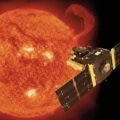Curious viewers can track the progress of the James Webb telescope in real time, thanks to a new, dedicated YouTube channel.
Launched a day after the telescope itself, the channel charts the current position of the groundbreaking space observatory, its rate of speed, percentage of the distance covered thus far, and a range of other technical data for the rebelliously curious mind.
BACKGROUND: TELESCOPE DELAYS & DEPLOYMENT STEPS
Astronomers and hobbyists alike have anxiously awaited the launch of Webb for years. Over the last year, the space observatory has endured a series of delays that pushed its eventual launch back to Christmas day 2021.
Now, the James Webb telescope is finally on its way to its destination. Once on site, it is expected to spend years, possibly even decades, gathering data about the early days of the cosmos, as well as scanning the atmospheres of exoplanets for signs of extraterrestrial life.
ANALYSIS: TRACKING THE TELESCOPES PROGRESS IN REAL TIME
As of the posting of this story, the telescope was just over 60% of the way to L2 (LaGrange Point 2), a gravitationally stable spot where the Earth shadows the observatory from sunlight, allowing it to search the much cooler infrared signals from deep space.
While on this journey, the telescope has been methodically going through its deployment steps, including extending its five individual sun shields. According to a recent statement from NASA project manager Bill Ochs, that particular step, which involved the successful unlocking of 107 different pins, “was really a huge achievement for us.”
The team is now in the process of slowly but surely tightening the five shields, and if all goes right, the series of steps needed to make this happen should be completed by this coming weekend.
“The best thing for operations is boring,” said Ochs of the shield tightening process, “and that’s what we anticipate over the next three days, is to be boring.”
The James Webb team notes that there have been a few obstacles in the days since its launch, including an overheating issue and a low power issue. Fortunately, the team was able to reposition the telescope’s solar panels to increase power and were also able to adjust Webb’s position to eliminate the overheating problem.
“Everything is hunky-dory and doing well now,” said Amy Lo, a lead engineer for Northrop Grumman, the telescope’s primary contractor, after these two issues were resolved and the shield tightening resumed.
OUTLOOK: AFTER YEARS OF WAITING, JAMES WEBB IS ONLY MONTHS AWAY
As of January 3rd, the first sun shield was successfully tightened, with the others to follow. After that, the segments of the mirror that were tucked into the Arianne 5 rocket faring will be moved into place, completing the telescopes massive mirror. That step will be followed by months of alignment to make sure the instrument is operating optimally.
All in all, NASA says that barring any major issues, the telescope should begin returning science data by the end of June. Until then, this new YouTube channel will continually update, including any statements made by NASA.
Follow and connect with author Christopher Plain on Twitter: @plain_fiction
